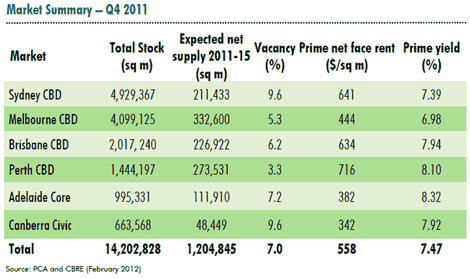Perth to lead growth in CBD office rents to 2016, but Melbourne risks oversupply: CBRE and BIS Shrapnel
Prime CBD office rents are expected to grow at a compound annual average of 3.8% per annum across Australia from 2012 to 2016, with the Perth CBD expected to be the strongest performer, according to the latest office market forecasts from CBRE.
The other positive developments over the first quarter of 2012 were stronger sales turnover, an increase in net absorption and an increase in white-collar employment.
Office rents in the Perth CBD are expected to grow by 4.5% over the four-year period, however all of the major CBD markets are expected to register rental growth at or above CPI during this period.
Buoyed by mining investment, Perth currently has the highest prime CBD rents in Australia (and seventh highest in the world), charging $716 per square metre, and also the tightest rental market, with a vacancy rate of just 3.3%, according to the CBRE report.
Click to enlargeCBRE regional director for office services James Patterson says the short-term outlook remains relatively flat in most markets except Perth, given that tenants are still cautious about the outlook for European financial markets.
“The expectation is that Europe will avoid a major recession, and the effect on the global economy will be minor,” he says.
“If this is the case, more bullish rental growth is expected from 2013 onwards, with fundamentals in most markets looking strong.”
According to Patterson, it will very much be a two-speed recovery, with resources being a key driver in the continued expansion of the Queensland and Western Australian economies – and by extension the Brisbane and Perth office markets.
“This is also expected to give South Australia a much-needed boost over the medium term as work begins on the Olympic Dam mining project,” he says.
“Conversely, slow revenue growth in the finance sector and professional services and limited activity in the government sector is likely to curtail short term growth in NSW, Victoria and the ACT. In addition, caution in the business sector is continuing to impact on the length of time taken for lease deals to be finalised.”
This week BIS Shrapnel economist Frank Gelber warned that Melbourne needed to stop building more offices.
“The Melbourne office market is not about to take off. It would be a worry if too many projects took off in Melbourne,” Gelber said.
However, the overall office outlook is good, with BIS Shrapnel expecting a weak supply pipeline and rising employment growth to put pressure on the existing office space stock.
“Vacancy rates will continue to fall and rental growth will begin to accelerate, especially for A-grade stock. As a result office commencements are forecast to lift a further 11% to $4.95 billion in 2012-13. Financing conditions are likely to remain tough, and pre-commitments will continue to drive the upturn,” says BIS Shrapnel in its latest forecasts.
CBRE senior manager for global research and consulting Luke Nixon expects supply and demand to remain largely in balance over the short term, keeping vacancy rates stable and acting as a stimulus for positive rental growth over the next five years.
The balanced state of the market was highlighted in the second half of last year when nearly 150,000 square metres of office stock was withdrawn from the market, but only 140,000 square metres of new or refurbished stock was added to Australia’s major office markets (the Sydney CBD, Melbourne CBD, Brisbane CBD, Perth CBD, Adelaide Core and Canberra’s Civic precinct) the first time in seven years that space has contracted in the major office markets.
“As vacant A-grade space continues to be absorbed there is expected to be growing demand from tenants for an increased development pipeline of high-quality space,” he says
“If the CBD markets cannot accommodate this demand, fringe markets are likely to be the beneficiaries.”
According to the CBRE report, prime rental growth in Melbourne slowed in the fourth quarter of 2011 to just 0.7% following growth of 1.2% and 2.4% in the previous quarters. For the year, total rental growth was 5%, the strongest since 2008.
In Sydney, total stock grew by 21,715 square metres over the period, while demand remained constrained, causing the CBD vacancy rate to grow slightly in the second half of last year.
Brisbane CBD was the only other city with an increase in total stock, however strong tenant demand translated to a reduction in the city vacancy rate to 6.2%.
The CBRE report also highlights that the office investment market is expected to remain strong through 2012, driven by foreign investors, unlisted funds and superannuation groups, with private investors active at the lower end.
Nixon expects A-REITs to continue to be net vendors of CBD office property until there was a significant increase in stock market valuations.
